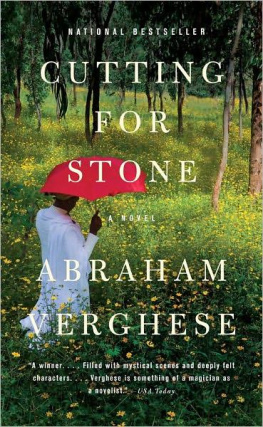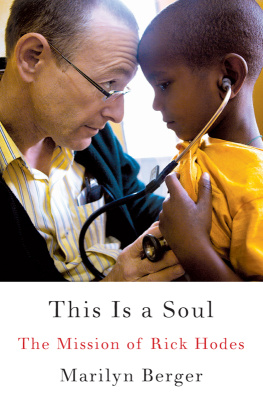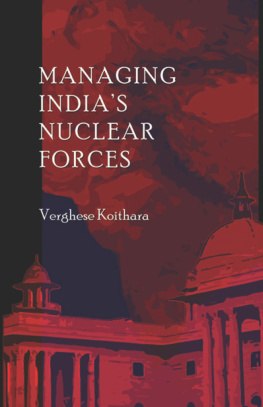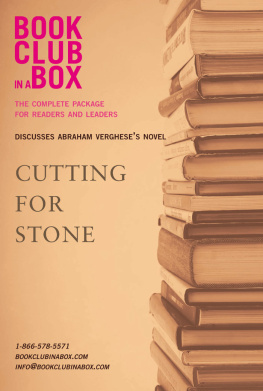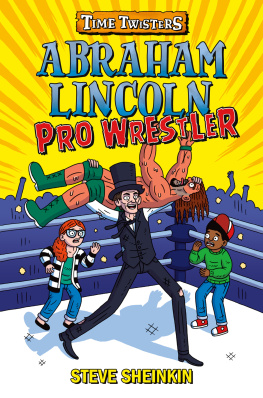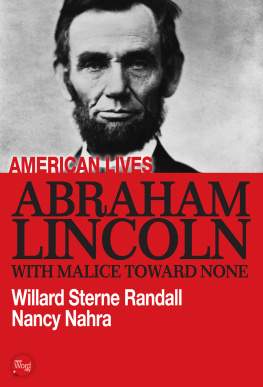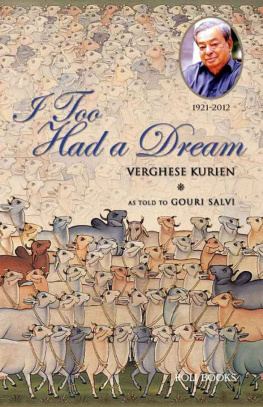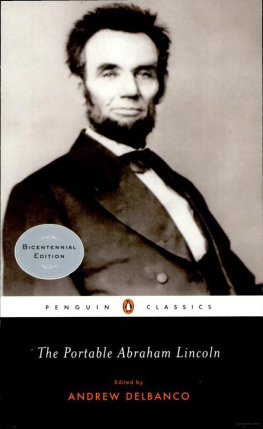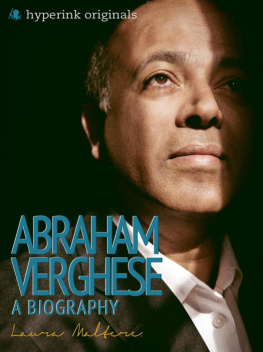Abraham Verghese - Cutting for Stone
Here you can read online Abraham Verghese - Cutting for Stone full text of the book (entire story) in english for free. Download pdf and epub, get meaning, cover and reviews about this ebook. year: 2009, publisher: Knopf Doubleday Publishing Group, genre: Non-fiction. Description of the work, (preface) as well as reviews are available. Best literature library LitArk.com created for fans of good reading and offers a wide selection of genres:
Romance novel
Science fiction
Adventure
Detective
Science
History
Home and family
Prose
Art
Politics
Computer
Non-fiction
Religion
Business
Children
Humor
Choose a favorite category and find really read worthwhile books. Enjoy immersion in the world of imagination, feel the emotions of the characters or learn something new for yourself, make an fascinating discovery.
- Book:Cutting for Stone
- Author:
- Publisher:Knopf Doubleday Publishing Group
- Genre:
- Year:2009
- Rating:4 / 5
- Favourites:Add to favourites
- Your mark:
- 80
- 1
- 2
- 3
- 4
- 5
Cutting for Stone : summary, description and annotation
We offer to read an annotation, description, summary or preface (depends on what the author of the book "Cutting for Stone " wrote himself). If you haven't found the necessary information about the book — write in the comments, we will try to find it.
Cutting for Stone — read online for free the complete book (whole text) full work
Below is the text of the book, divided by pages. System saving the place of the last page read, allows you to conveniently read the book "Cutting for Stone " online for free, without having to search again every time where you left off. Put a bookmark, and you can go to the page where you finished reading at any time.
Font size:
Interval:
Bookmark:
T HIS IS A WORK OF FICTION, and all the characters are imagined, as is Missing Hospital. Some historical figures, such as Emperor Haile Selassie and the dictator Mengistu, are real; an attempted coup did occur in Ethiopia, but five years earlier than the one I describe. The Colonel and his brother are loosely based on the real coup leaders. The details of their capture and the words at the Colonel's trial and before he was hung are from published reports, particularly Richard Greenfield's Ethiopia: A New Political History; John H. Spencer's Ethiopia at Bay: A Personal Account of the Haile Selassie Years; the published work of Richard Pankhurst for historical backdrop; and Edmond J. Keller's Revolutionary Ethiopia: From Empire to People's Republic. A remarkable physician by the name of John Melly died after being shot by a looter, but his dialogue with Matron is imagined. The Ibis and other bars are inventions. The LT&C school is imagined; any resemblance to my wonderful school (where Mr. Robbs and Mr. Thames encouraged my writing) is not intentional.
The following sources, books, and people were invaluable: The birth scene and the phrases white asphyxia and in the obscurity of our mother's womb are inspired by the wonderful memoir of the late great Egyptian obstetrician and fistula surgeon Naguib Mahfouz, The Life of an Egyptian Doctor, as is the idea of the copper vessel. Nergesh Tejani's essays describing her experiences in Africa with version clinics and with fistula, as well as our correspondence, were extremely helpful. I consulted the published work of Dr. Reginald Hamlin and Dr. Catherine Hamlin, pioneers of fistula surgery. As a medical student, I would see them and was very aware of their work. Recently, I had the opportunity to visit the Hospital by the River, which is also the title of Catherine Hamlin's lovely memoir. The fistula surgeons in my book are not in any way based on the Hamlins. The late Sir Ian Hill was in fact the dean of the medical school, and if I use his name, and that of Braithwaite, in the book, it is as a tribute to two people who took a chance on me. The attempted hijackings of the Ethiopian Airlines jets during the 1960 s and 1970 s are historical facts; one would-be hijacker was my senior in medical school; she and her fellow hijackers perished in the attempt. The present prime minister of Ethiopia, Meles Zenawi, was one year my junior in medical school; he became a guerilla fighter, ultimately leading the forces that toppled Mengitsu. The heroism of the security crew and the incredible skill of the pilots are very real. Ethiopian Airlines remains, in my opinion, the safest and best international airline I have flown, with the most hospitable and dedicated flight attendants. Louse-borne relapsing fever was studied by the late Peter Perine and the late Charles Leithead, and I had the pleasure of seeing patients with both men when I was a student.
For information about Teresa of Avila, and the description of Bernini's statue, I drew on Teresa of Avila: The Progress of a Soul by Cath-leen Medwick. Even after seeing the original in Rome, I found Med-wick's descriptions so insightful. Any of St. Teresa's words that I quote, as well as the ideas about faith and grace, and the idea of Sister Mary Joseph Praise reciting the Miserere at her death and the idea of the inex-picably sweet scent, are based on Medwick's account of the life of Teresa. The words celestial billing and cooing are from H. M. Stutfield quoted in Medwick's book.
The line I owe you the sight of morning is by W. S. Merwin from the poem To the Surgeon Kevin Lin, originally published in The New Yorker. A limited-edition print of this poem prepared by Caro lee Campbell of Ninja Press and signed by William Merwin hangs in my office. I owe a great debt to physician, writer, and friend Ethan Canin for first inviting me to the Sun Valley Writers Festival and thereby introducing me to Reva Tooley and the remarkable people who gather there.
The line her nose was sharp as a pen is from Henry V, Part II and relates to my belief that it represents Shakespeare's astute clinical observation, which I described in The Typhoid State Revisited, in The American Journal of Medicine (:; 1985 ).
My own impressions of Aden and my memories of sitting in khat sessions were aided by the most vivid descriptions in Eric Hansen's wonderful book Motoring with Mohammed: Journeys to Yemen and the Red Sea and also Eating the Flowers of Paradise: One Man's Journey Through Ethiopia and Yemen by Kevin Rushby. The image of the woman with the charcoal brazier on her head and also the wheelbarrows transporting people come from Hansen's book.
The Italian occupation, the description of Aweyde, and many aspects of the Italian-Ethopian conflict, including the desire to win by any meansQualsiasi mezzowere informed by Paul Theroux's wonderful Dark Star Safari: Overland from Cairo to Capetown and many other sources.
Squared her shoulders to the unloveliness is a paraphrase of James Merrill's line in the poem Charles on Fire: No one but squared / The shoulders of his unloveliness.
Bliss Carnochan showed me an early edition of his Golden Legends: Images of Abyssinia, Samuel Johnson to Bob Marley and helped me see how Western ideas about Ethiopia were shaped.
I and countless Commonwealth medical students admired Bailey and Love's Short Practice of Surgery; Stone's imagined textbook is based on Bailey and Love, and the wombat and the appendix story is from there. As a student I was impressed with the photograph of Bailey and his nine fingers. Other than that, the character of Stone has no connection with Hamilton Bailey, who practiced only in England before retiring.
A careful decision was needed so as not to blunder again. It was often the second mistake that came in the haste to correct the first mistake that did the patient in and A rich man's faults are covered with money, but a surgeon's faults are covered with earth are both from Aphorisms and Quotations for the Surgeon by Moshe Schein. For these and many other surgical notions, I owe Moshe, maverick surgeon, brilliant teacher, author of several wonderful surgical textbooks, essayist, and friend. He not only read early drafts but also introduced me to the community of surgeons on SURGINET I delighted in, learned from, and borrowed ideas from their musings, particularly the vasectomy details, which made for a series of memorable exchanges. Karen Kwong shared with me her experiences (and those of her husband, Marty) as a trauma surgeon, and she was a careful reader of the manuscript both early and at the end. Her long, thoughtful e-mails were precious, and I cannot express to her sufficiently my gratitude and admiration. Thanks also to Ed Salztein, Jack Peacock, Stuart Levitz, and Franz Theard. I met Thomas Starzl when I was a Chief Resident in Tennessee and have since renewed the acquaintance. He is truly a surgeon's surgeon, and his pioneering work establishing the field of liver transplantation is no fiction; I refer to him in the book in tribute. Thomas Stone is his fictional contemporary. Francisco Cigarroa, president of the University of Texas Health Science Center, San Antonio, was kind enough to let me watch as he performed a liver transplant on a child. The remarkable group in San Antonio, led by Glenn Halff, who make liver transplant appear almost routine, are part of Starzl's legacyuntil very recently, it was fair to say that every liver transplant surgeon in the world was trained by Starzl or by someone who trained with Starzl.
Birth, and copulation, and death / That's all the facts when you come to brass tacks: I've been born, and once is enough is a partial quote form T. S. Eliot's
Font size:
Interval:
Bookmark:
Similar books «Cutting for Stone »
Look at similar books to Cutting for Stone . We have selected literature similar in name and meaning in the hope of providing readers with more options to find new, interesting, not yet read works.
Discussion, reviews of the book Cutting for Stone and just readers' own opinions. Leave your comments, write what you think about the work, its meaning or the main characters. Specify what exactly you liked and what you didn't like, and why you think so.

